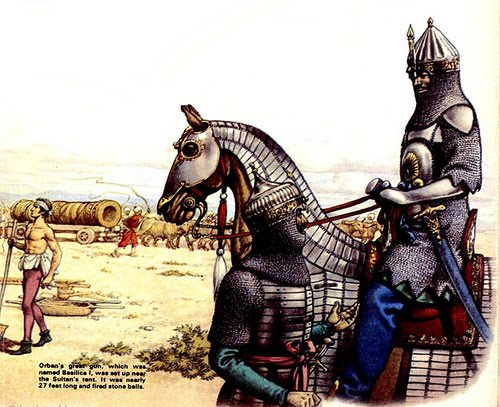Timarlý Sipahis
By VEYSEL ŞİMŞEK
In the classical age, a medieval cavalry arm, the Timarlý Sipahis (timariot cavalry) along with the permanent salaried troops, formed the backbone of the Ottoman field army. Various auxiliary detachments as well as the forces of vassal principalities could also be added to regular army. The timariot cavalry enjoyed the advantage of being a part of the privileged ruling class (askeri) in the Ottoman society. They received a portion of income from their allocated timars and were exempt from taxation. In exchange, they were required to train a certain number of cavalrymen (cebelüs), the exact number depending on the income which they received. They were required to join campaigns with men, to collect taxes for the central treasury, and finally to maintain order in their home districts. In an imperial campaign, they were subordinated respectively to their sub-provincial commanders (sancakbeys), the provincial commanders (beylerbeys) while joining the combined imperial army. The ideal campaigning season for the timariot cavalry was from March to October, after which they returned back home. If a timarlý sipahi did not perform the assigned military tasks for seven years, his privileged askeri status would be revoked, and he could well become a member of the reaya subject class. Although they had to carry out policing duties in their home areas, timarli sipahis did not have any judicial authority over the peasants from whom they collected taxes. More importantly, their control over the land and peasants was strictly limited to their own lives. Since the Sultan and the state was the ultimate owner of the land, a system inherited from the earlier Islamic and other Middle Eastern states, the timariot cavalryman, regardless of rank, could not leave his holding to heirs. The class structure, however, did persist, since the son of a timariot cavalryman could automatically be a member of the askeri class and start over with a smaller timar that would be allocated to him. The Ottoman center thus sought to prevent the establishment of local roots in the provinces through the inheritance of large tracts of timars directly by the sons of the timarli sipahis.
Another important component of the Ottoman army was the kapýkulus, who were the salaried permanent troops stationed in the capital and provincial garrisons. This corps included the infantry regiments (the famous Janissaries), the elite cavalry of the Porte, cannoneers, grenadiers, sappers and various supporting units. The men in the kapikulu corps were not as numerous as the timariot provincial cavalry, but they had the best available military training and equipment and shared a definite esprit de corps in their regiments as well as in their entire military organization. The early sultans depended on them as shock troops in the critical battles and used them to man garrisons throughout the empire. Though not numerically great in size, they were very much the trusted and promoted arm of the sultan and the central authority, thanks to their regular salaries and the devşirme system employed to recruit them, which created a group of soldiers without any roots who therefore became devoted servants (military or civil), being loyal only to their masters.
